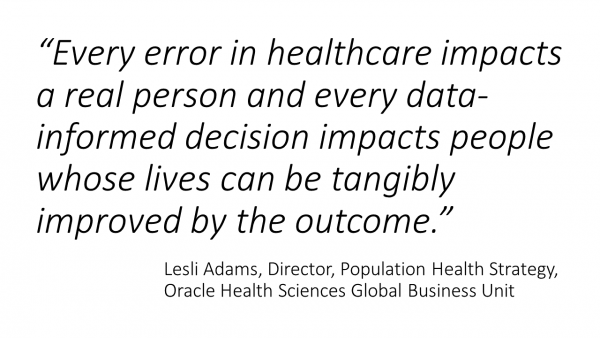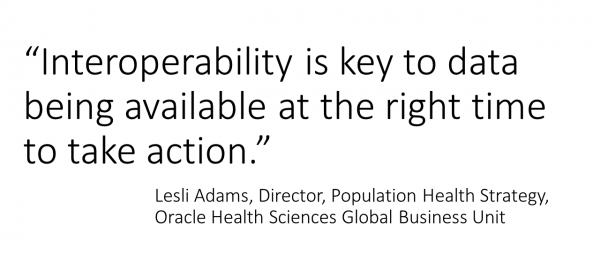When I talk to people throughout the healthcare industry one topic that always seems to come up is population health management. Healthcare organizations are focused on managing the health of the individuals and populations that they serve. With HIMSS16 just around the corner I tracked down Lesli Adams, Director Population Health Strategy, Oracle to get her insights on this hot topic.
 Lesli Adams, MPA is a Director of Population Health Strategy with a background of driving healthcare technology strategies for Oracle, Tenet Healthcare Corporation and the University of Texas MD Anderson Cancer Center. Expertise in population health analytics, predictive risk modeling, partner / channel relationships and enterprise data models. Experience with academic, for profit, integrated delivery networks, government, payers and military healthcare systems.
Lesli Adams, MPA is a Director of Population Health Strategy with a background of driving healthcare technology strategies for Oracle, Tenet Healthcare Corporation and the University of Texas MD Anderson Cancer Center. Expertise in population health analytics, predictive risk modeling, partner / channel relationships and enterprise data models. Experience with academic, for profit, integrated delivery networks, government, payers and military healthcare systems.
KATE: What technologies are critical for healthcare organizations to have in place in order to manage population health?
LESLI: It is important to understand that population health and optimal patient care comes from multiple and disparate source systems. These systems require processes and methodologies to aggregate and normalize data to create actionable insights for today’s healthcare leaders. Every error in healthcare impacts a real person and every data-informed decision impacts people whose lives can be tangibly improved by the outcome. Accuracy in analyzing and acting upon data means healthcare organizations must hold themselves to an elite standard in managing data to be used in informing life-impacting decisions. Accurate data is the starting point needed to fulfill population health activities across care guidelines, quality indicators, risk stratification, and patient engagement.
Successful technology implementation requires people, processes, and technology. The decision to select a technology should also encompass the processes to be adapted and incorporated and the people required to make those processes successful. For population health, consideration of the people and the process involved in a technological solution is crucial. The people and process are the intersection of patient care and the knowledge base to evaluate, diagnose, and design a treatment plan. Technology choices need to be made that facilitate the ability to aggregate data, create actionable analytics, and deliver effective prioritization.
KATE: How is patient-generated health data and portals used to improve patient outcomes
LESLI: Patients and care providers use workflows and alerts for disease management and device readings based on evidence-based protocols to improve compliance outside the facility. Engaging the patient through a portal that shares the patient’s results facilitates a “patient-centered” care model that encourages wellness and disease management. Just as managing your bank statement and check book ensures you save and spend appropriately, using portals and patient level data ensures healthy outcomes This data can be driven to the enterprise data warehouse for a 360 view of the patients within a population.
KATE: Why is patient engagement a key to population health management? What are the success factors in patient engagement for population health?
LESLI: Today, population health incorporates everything from finger print identification, electronic medical records and patient engagement, to clinical care gaps, outcome measures, patient safety, and patient satisfaction. Population health encompasses all the individual characteristics and needs of the people who ultimately form that population. If applied correctly, population health can be the ultimate yardstick of U.S. healthcare.
KATE: What is the value of interoperability in care coordination and population health management?
LESLI: Healthcare providers and facilities must be responsive to ensure that patient care at the point of care uses the right guideline, the right utilization of service, with the right access to care without delay. The Triple Aim. In light of accelerating reimbursement changes, these processes will ensure better financial and clinical decision making to optimize treatment planning. The ability to deliver optimal care is dependent on data availability, actionable insight, and effective prioritization. Interoperability is key to data being available at the right time to take action.
KATE: What is the biggest challenge in regards to population health management?
LESLI: The core of healthcare has always been, and will always be, the relationships between patients and providers. Patients need access to their providers to share their needs, concerns, and requests. Communication, sharing of information between patients and providers, is essential to care. Care happens when patients share and providers evaluate, with a continuous trust built through ongoing communication. The data that is generated from that patient and provider intersection then creates downstream analytics, allowing the entire care team and broader health care organization to work smarter in providing care for individual patients, as well as the entire community that they serve.
KATE: How can organizations leverage data and analytics to manage populations
LESLI: Analytics and nuances of care coordination, risk stratification, cohort identification, population sub-setting become critical to providers and those supporting their delivery of care (CMO, CMIO, Chief Nursing Officer [CNO], and Clinical Decision Support Analysts), as their daily lives are focused on segmenting their patients in the most optimal way. These new patient segments can be used to identify a new service line, a specific clinical trial study group, at-risk patients, and over/under utilizers of services.
Lets continue the conversation at HIMSS. Lesli will be presenting about Population Health – click the link to add this to your agenda. Stop by and see Lesli at the Oracle booth throughout the HIMSS conference and join her and Perficient’s Terie McClintock on Wednesday, March 2 from 4-6 PM PT in the Population Health Knowledge Center – Kiosk #14106. Add to Calendar





Great insights in this post! One challenge I’ve seen many healthcare organizations face is effectively using the data they collect to actually improve patient outcomes. Population health management sounds great in theory, but without the right systems and follow-up strategies, it can be overwhelming to translate all that data into actionable care plans. I’ve found that even small steps, like prioritizing high-risk patients for outreach, can make a noticeable difference. For anyone looking for practical ways to implement these strategies in urgent care settings, we’ve shared some approaches here: [https://rapidurgentcaretx.com/].